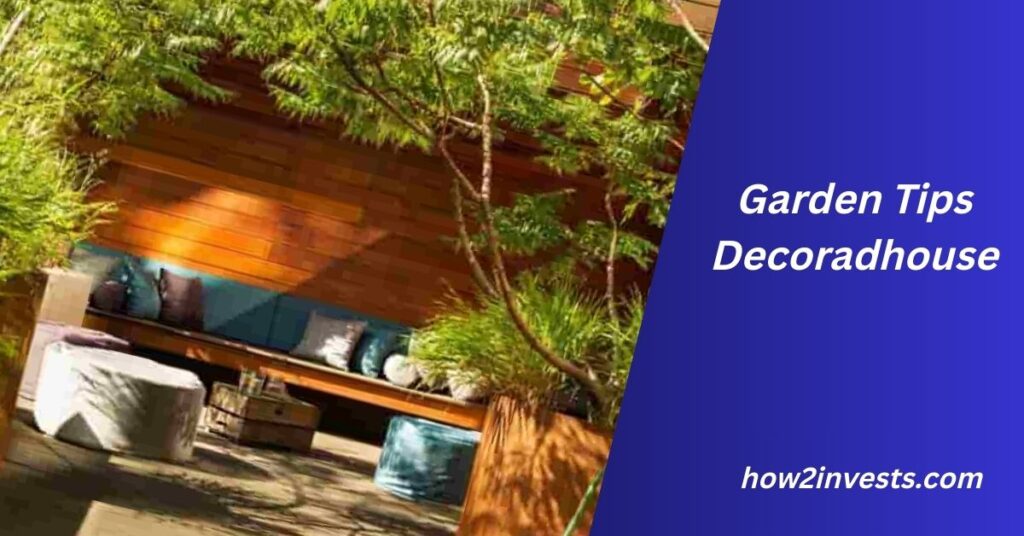Garden Tips Decoradhouse: The Ultimate Guide to Transforming Your Outdoor Space

Gardening is one of the simplest yet most rewarding ways to enhance your home. It connects you with nature, adds beauty to your surroundings, and gives you a peaceful escape from daily stress. But to make your garden truly special, you need more than just plants. You need thoughtful design, creative decor, and sustainable practices. That is where garden tips decoradhouse comes in.
Garden tips decoradhouse is a combination of gardening techniques and decorative ideas designed to help you maximize both functionality and style in your outdoor space. Whether you have a large backyard, a compact patio, or even a small balcony, these tips can help you create a space that feels like a natural extension of your home.
In this complete guide, we’ll explore everything you need to know about planning, planting, decorating, and maintaining your dream garden.
Understanding Garden Tips Decoradhouse
Before diving into specific strategies, let’s break down what garden tips decoradhouse really means. It isn’t just about throwing some flowers in the soil or buying a few outdoor chairs. Instead, it’s a holistic approach to designing outdoor spaces with both beauty and practicality in mind.

- Gardening Basics: Planting, watering, soil care, and seasonal planning.
- Decorative Elements: Furniture, lighting, artwork, and accessories that enhance outdoor aesthetics.
- Functionality: Making sure your garden supports different activities such as relaxation, play, or even dining.
- Sustainability: Using eco-friendly practices to create a garden that’s kind to the planet.
Think of it as combining the skills of a landscaper, an interior decorator, and a sustainability expert all in one.
Smart Garden Layout Tips from Decoradhouse
Your garden’s layout is the foundation of everything else. Without a well-thought-out plan, even the most beautiful plants or decor will look scattered. Garden tips decoradhouse emphasizes intelligent garden layouts that save space, improve usability, and keep your garden looking balanced.
Also Read: Famous Parenting Mom Life: A Complete Guide to the Chaos and Joy of Motherhood
Create Enough Vertical Space
If you’re short on ground space, don’t worry—look up. Vertical gardening is one of the most practical solutions for small gardens, patios, and balconies.
- Install trellises for climbing plants such as ivy, roses, or peas.
- Use hanging baskets for flowers like petunias or strawberries.
- Try vertical planters with compartments to grow herbs, lettuce, or succulents.
By going vertical, you not only save space but also create a dynamic look that adds depth and visual interest to your garden.
Keep Easy Access to Plants
Accessibility is key. Imagine planting a vegetable patch only to realize later that you can’t comfortably reach half the crops without stepping on other plants.
- Design pathways using gravel, stepping stones, or wooden planks.
- Leave enough spacing between rows of vegetables.
- Place frequently used herbs like basil, parsley, and mint close to the kitchen door.
Easy access saves time and makes maintenance less frustrating.
Reserve Space for Different Activities
A modern garden isn’t just for plants—it’s a living space. When planning, ask yourself: What else do I want to do here?
- Add a seating corner with benches or chairs for reading or morning coffee.
- Designate a play area for kids with safe turf or sand.
- If you love entertaining, create an outdoor dining area with a small grill or fire pit.
Multifunctional gardens give you more value for your effort and investment.
Go for Sustainable and Eco-Friendly Designs
Sustainability is not a trend—it’s the future of gardening. By adopting eco-friendly designs, you’ll save money while protecting the environment.
- Collect rainwater using barrels to water your plants.
- Use compost bins to recycle kitchen waste into fertilizer.
- Choose native plants that require less maintenance and water.
- Install solar-powered lights instead of electric ones.
A sustainable garden is low-maintenance, budget-friendly, and eco-conscious.
Planting Advice for Every Season
Plants have their own rhythms, and respecting seasonal cycles is one of the most important aspects of successful gardening. Garden tips decoradhouse offers practical planting schedules for each season so you can enjoy blooms and harvests year-round.
Also Read: Directory ArcyArt – The Complete Guide for Art Enthusiasts, Collectors, and Creators
Spring Planting
Spring is the season of renewal. After winter, your garden craves fresh life.
- Flowers: Tulips, daffodils, pansies, and lilacs add vibrant colors.
- Vegetables: Lettuce, carrots, beans, and peas grow quickly in spring soil.
- Tips: Use mulch to keep soil moist and start seedlings indoors if frost is still possible.
Summer Planting
Summer brings heat and long days, perfect for sun-loving plants.
- Flowers: Sunflowers, lavender, and marigolds flourish under strong sunlight.
- Vegetables: Tomatoes, peppers, cucumbers, and zucchini thrive in warm soil.
- Tips: Water deeply in the mornings to prevent evaporation. Shade-sensitive plants with netting if needed.
Autumn Planting
Autumn is the time to prepare your garden for winter and spring.
- Vegetables: Kale, spinach, garlic, and broccoli handle cooler weather well.
- Flowers: Plant bulbs such as tulips, hyacinths, and daffodils for spring blooms.
- Tips: Clean up fallen leaves and use them in your compost pile.
Winter Planting
Winter may seem lifeless, but it doesn’t have to be.
- Plants: Evergreens like pine, holly, and boxwood keep your garden green.
- Indoor Gardening: Grow herbs like rosemary, thyme, and mint in pots indoors.
- Tips: Protect roots with mulch, and bring sensitive potted plants indoors.
Garden Decor Ideas That Elevate Style
A garden should feel like a reflection of your personality. By combining plants with decor, you can create an outdoor space that feels cozy, stylish, and welcoming.
Use Lighting to Add Ambiance
Outdoor lighting completely transforms your garden’s atmosphere.
- String fairy lights across fences or pergolas.
- Place solar-powered lanterns along pathways.
- Add spotlights to highlight special plants or water features.
Lighting extends the usability of your garden into the evening, creating a magical ambiance.
Incorporate Water Features
Water adds life and movement to your garden.
- Birdbaths attract feathered visitors.
- Small fountains create soothing sounds that help you relax.
- A pond with fish or water lilies adds a sense of tranquility.
Even a tabletop water feature can make your garden feel more alive.
Choose Furniture That Matches Nature
Furniture should blend seamlessly with your outdoor environment.
- Wooden benches look natural and rustic.
- Rattan chairs provide comfort with style.
- Stone or concrete tables add durability and elegance.
Choose weather-resistant materials to ensure longevity.
Add Art and Decorative Pieces
Your garden is also a canvas for creativity.
- Mosaic stepping stones bring color to pathways.
- Sculptures or statues make bold focal points.
- Wind chimes add sound while enhancing the aesthetic.
These personal touches make your garden uniquely yours.
Sustainable Gardening Tips Decoradhouse
Sustainability isn’t just about being eco-friendly—it’s also about reducing effort and cost in the long run.
- Composting: Turn kitchen scraps like vegetable peels, eggshells, and coffee grounds into rich soil.
- Rainwater Harvesting: Install a barrel to collect water from your roof gutters.
- Pest Control: Use natural solutions like neem oil, ladybugs, or garlic spray instead of harmful chemicals.
- Soil Enrichment: Rotate crops and plant cover crops to maintain soil fertility.
- Recycled Decor: Repurpose old tires as planters or use reclaimed wood for raised beds.
DIY Garden Projects You Can Try
Adding personal touches to your garden makes it more meaningful. Decoradhouse encourages DIY projects that are budget-friendly and creative.
Also Read: Dreamwithjeff . com: Your Ultimate Resource for Inspiration and Creativity
- Build raised beds with reclaimed wood for better soil control.
- Paint terracotta pots with bright colors to add vibrancy.
- Create a vertical herb wall in your kitchen or patio.
- Craft bird feeders from recycled bottles or wood.
- Lay a pebble mosaic pathway for an artistic touch.
These projects are fun, affordable, and customizable.
Common Mistakes to Avoid in Garden Design
Learning from mistakes is important, but avoiding them from the start is even better.
- Planting non-native species that struggle in your climate.
- Overcrowding plants, which limits airflow and stunts growth.
- Forgetting to plan for maintenance and watering schedules.
- Buying decor or furniture that isn’t weatherproof.
- Ignoring soil quality and drainage needs.
Avoiding these mistakes ensures a smoother gardening experience.
Garden Tips Decoradhouse for Small Spaces
Even if you live in an apartment or have only a tiny backyard, you can still have a beautiful garden.
- Use balcony railing planters for flowers and herbs.
- Grow microgreens or herbs indoors on a windowsill.
- Choose compact furniture that folds away when not in use.
- Train climbing plants like jasmine or roses to cover walls.
- Mix edible plants with decorative ones for both beauty and function.
Small gardens can be just as stunning as large ones when designed creatively.
Final Thoughts
Garden tips decoradhouse is more than gardening advice—it’s a philosophy for living better with nature. By combining smart planning, seasonal planting, stylish decor, and sustainable practices, you can create a garden that enhances your home and improves your lifestyle.
Whether you dream of a lush backyard, a modern balcony garden, or a small indoor herb corner, these tips will guide you toward success. The best gardens aren’t just beautiful; they are functional, eco-friendly, and deeply personal.
FAQs About Garden Tips Decoradhouse
What does garden tips decoradhouse mean?
It’s a blend of gardening techniques and home decor strategies designed to make outdoor spaces both functional and stylish.
Can these tips work in small apartments?
Yes, vertical gardening, balcony planters, and indoor pots are perfect for apartments.
How do I start an eco-friendly garden?
Begin with composting, rainwater collection, and choosing native plants.
What’s the easiest beginner plant?
Herbs like basil, mint, and parsley are easy to grow and require little care.
Do I need expensive decor for my garden?
Not at all—many decoradhouse tips encourage using recycled or DIY projects to save money.




